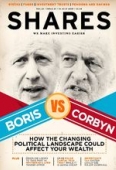Archived article
Please note that tax, investment, pension and ISA rules can change and the information and any views contained in this article may now be inaccurate.
Hopes of US rate cuts recede on jobs spike

Markets have been thrown into confusion after the US non-farm payrolls showed a much larger increase in hiring than analysts had expected, raising fears that the US Federal Reserve might not cut interest rates at its meeting on 31 July.
Such is the ‘looking-glass world’ that markets are experiencing that bad economic news is considered good for stocks if it increases the chances of an interest rate cut and good economic news is bad for stocks as it might delay a cut in rates.
WHY DO PAYROLLS MATTER?
Every month the Bureau of Labour Statistics collects data on the number of new jobs created in the US public and private sector across all industries excluding agriculture.
In theory, because the data is backward-looking instead of forward-looking – unlike the purchasing managers’ index (PMI) which is tracked each month – it shouldn’t have that much influence on markets.
However, after May’s dismal reading showed just 72,000 new jobs being added to the economy, analysts and investors had assumed that a 0.25% cut in rates this month was ‘a given’. Sadly nothing in markets is ever a given.
In general, when 200,000 new jobs or thereabouts are being added to the economy every month, the situation is considered to be ‘healthy’. So when the figure came in at 224,000 last week, with the market pricing in a much lower number, investors were clearly rattled and stocks were sold off.
US interest rate expectations have undergone a remarkable change in the last six months. Instead of a rise in interest rates, markets had been discounting several interest rate cuts instead.
ARE RATE CUTS OFF THE TABLE FOR NOW?
Experience suggests that one set of jobs data is unlikely to change the Federal Reserve’s thinking on interest rates either way.
Looking at the rest of the non-farm report, the unemployment rate actually rose slightly from 3.6% to 3.7%, although it is still close to record lows, while annual wage growth was flat at 3.2%.
On the face of it the jobs market would seem to be in rude health and not in need of a rate cut to stimulate hiring. Meanwhile food and energy prices are rising by less than 2% and are not expected to pick up in the near future.
However with the US stock market trading at all-time highs and analysts and investors banking on a rate cut this month, the Federal Reserve has a tough decision to make. The economy may not warrant a rate cut for now but markets are likely to sell off hard if one isn’t forthcoming.
Important information:
These articles are provided by Shares magazine which is published by AJ Bell Media, a part of AJ Bell. Shares is not written by AJ Bell.
Shares is provided for your general information and use and is not a personal recommendation to invest. It is not intended to be relied upon by you in making or not making any investment decisions. The investments referred to in these articles will not be suitable for all investors. If in doubt please seek appropriate independent financial advice.
Investors acting on the information in these articles do so at their own risk and AJ Bell Media and its staff do not accept liability for losses suffered by investors as a result of their investment decisions.

 magazine
magazine









